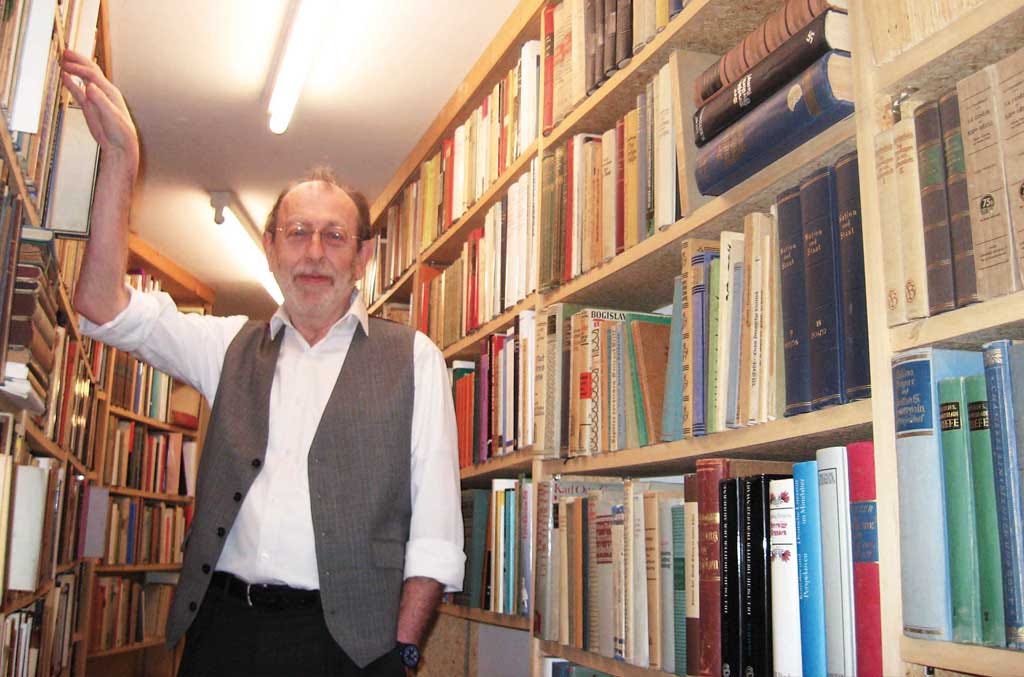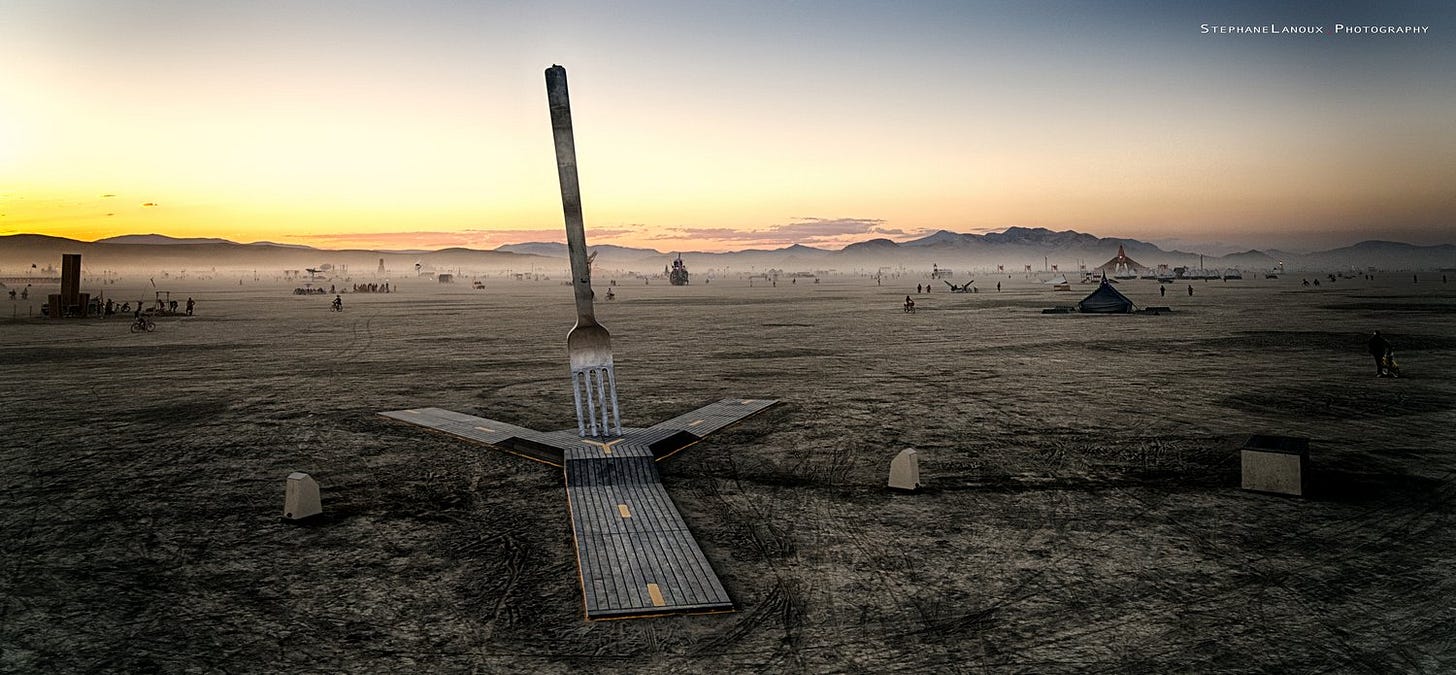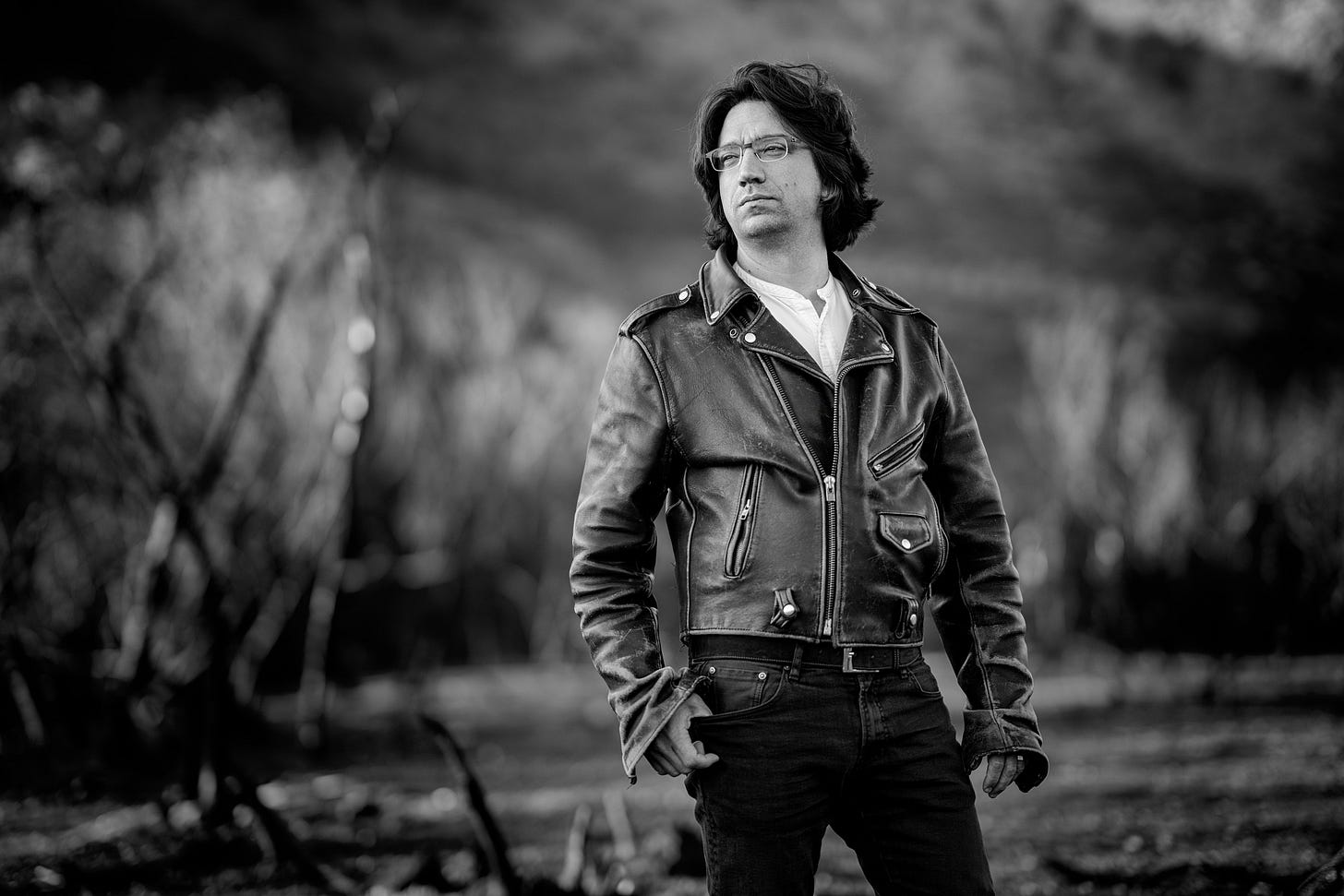Archeofuturism: The Secret Doctrine of the American Techno-Right
From French Fascist Civilizational Cult to Silicon Valley Strategy—and Washington, D.C.
Hey, Slick!
You’ve probably noticed the vibe shift. But have you clocked the oddities?
Crusader memes. Civilizational collapse.
Tweets about sacred war, mythic destiny, and the Kali Yuga.
Crypto bros quoting René Girard and Joseph de Maistre.
Candidates name-dropping Nietzsche and Carl Schmitt on the trail.
Podcasts flirting with monarchy—half joke, half blueprint.
Peter Thiel, once a libertarian icon, now a devout Catholic—building military AI and calling democracy a failed experiment.
His co-religionist JD Vance—the Vice President—praying for victory in a Signal chat.
Even church is cool again. If not for God, then for order. For mystery. For meaning.
Among crypto bros, dissident podcasters, and New Right influencers, liturgy has become the new punk: incense, Latin, and robes standing in for rebellion.
It’s weird. And it’s deeper than runes carved on an AR-15, stronger than memes, sharper than Warrior-Jesus.
Something in the Right’s intellectual architecture has changed.
It’s no longer about tax cuts and tough talk.
It’s about rebuilding civilization after collapse—and deciding who gets to rule it.
I. Prologue: The Hidden Blueprint of the American New Right
Forget fentanyl, foreign automobiles, or Canadian lumber; forget even MAGA hats and Russian psyops. America’s most dangerous imports don’t come in shipping containers. They come in footnotes.
Obscure French theorists.
Of course, it’s French…

The American Right is no longer just nostalgic or reactionary. It has become post-democratic, mythic, and ruthlessly elite-driven—civilizational in rhetoric, accelerationist in policy, medieval and sci-fi in aesthetic.
Behind the slogans and strategies lies something stranger: a new scaffolding of belief, built from the bones of forgotten philosophers and fringe ideologues once dismissed as too extreme, even for the postwar European far-right.
This is the story of the Nouvelle Droite, the French New Right: an intellectual movement that sought to re-enchant the Right by borrowing tools from the Left—Gramsci, Foucault, Deleuze—to rebuild power through culture, not elections.
And it’s the story of the firebrand they exiled for saying the quiet part too loudly—clashing with their careful attempts to sanitize the message, gain intellectual respectability, and shed the fascist stench.
He didn’t veil his ideas in theory. He embraced collapse, sacred war, and high-tech sovereignty.
He didn’t want to preserve Western tradition. He wanted to forge a new civilizational order from its ruins.
He was too extreme for the movement he helped shape—exiled for refusing to disavow racial theory, fascist aesthetics, and far-right spectacle.
We’re talking about a man who once acted in a porn film set in a Nazi concentration camp. And who, when he spent a decade in exile, reinvented himself—of all things—as a shock-jock comedian on the largest French hip-hop radio station for teenagers.
And you would think these two things would discredit him, Slick. But his ideas didn’t die: they metastasized.
He’s not cited—still radioactive—but he’s everywhere. Not in manifestos or campaign speeches, but in the logic of how power is being rebuilt: outside the state, above the law, and beneath the radar.
His name was Guillaume Faye.
And his vision might explain everything from Trump 2.0 to Elon’s Mars talk to Peter Thiel’s bunker logic.

But to understand how it spread, we have to go back to France in the 1970s—
to a moment when the far right stopped marching in jackboots and started whispering in libraries and salons.
II. The French New Right: Metapolitics and Myth as Strategy
To understand Faye, you need to understand the movement he came from (and that later exiled him), the Nouvelle Droite.
By the late 1960s, the French far right was intellectually bankrupt and politically toxic—haunted by Nazi sympathies, Vichy nostalgia, and a bitter defense of the crumbling French Empire. It needed a reinvention.
The Nouvelle Droite (New Right) emerged in the late 1960s, in the aftermath of decolonization and the upheavals of May ’68. And it wasn’t just a revival—it was a repackaging. Out went the jackboots and racial slurs; in came postmodernism, myth, and “cultural identity.”
Shaped by a sense of civilizational decline, its thinkers sought to rebuild the traditionalist Right—not primarily through party politics, but through cultural transformation. They realized that electoral success would mean little without first reshaping the foundations of belief and identity.
Their strategy, called metapolitics, drew from Gramsci’s theory of cultural hegemony. Political power, they argued, was downstream from culture. To shift history’s course, they had to win the long war of ideas—by influencing media, universities, and public discourse. This meant distancing themselves from overt fascism and biological racism, and building a new ideological foundation that could be intellectually legitimate and socially acceptable.
What began as leftist critiques of power, identity, and modernity was recast—not to liberate, but to rearm the Right. Drawing from leftist tools, including structuralism and postmodernism, they dismantled the Enlightenment ideals of universalism and egalitarianism. Foucault’s critique of power, Deleuze and Guattari’s rhizomes, even Debord’s spectacle were reframed1—not to resist domination, but to build a new mythic order immune to liberal illusions. In this worldview, myth isn’t entertainment: it’s the operating system of rule.
Instead of racial hierarchies, they promoted ethnopluralism—the idea that distinct cultures and peoples should remain separate to preserve their unique identities. It was still a politics of exclusion, but dressed in the language of cultural rights and difference. The movement’s leading figure, Alain de Benoist, advanced these ideas with academic poise and philosophical depth. Many within the movement also rejected Christianity in favor of pre-Christian European paganism, seeing in it a mythic and symbolic framework more resonant with ancestral memory and civilizational strength.
While they didn’t openly call for a European ethnostate, the implications of ethnopluralism were clear: if cultural intermixing leads to civilizational decline, then some form of cultural and geographic separation is necessary to preserve identity. Not always defined by strict borders, but by a sense of ancestral continuity, spiritual sovereignty, and symbolic homeland.
After the Holocaust, overt antisemitism was no longer useful. But fear still needed a face. And so the enemy shifted—from Jews to Muslims. It was easier to blame those arriving in growing numbers—immigrants with headscarves and foreign languages—than to resurrect hatreds too closely tied to genocide. Islam, unlike Judaism, could be framed as both alien and ascendant. And as terrorism began to dominate headlines, the pivot sold itself.
Their goal wasn’t populist revolt. It was elite persuasion. Not seizing power, but making right-wing traditionalism intellectually viable again—a worldview that could outlast liberal modernity and shape what came next.
It wouldn’t be the first time the French developed a radical theory of power—only for the enemy to use it more effectively. After WWI, French strategists (note: including de Gaulle) pioneered what would become blitzkrieg—rapid mechanized warfare, combined arms, mobile armor. The French high command ignored it. The Germans didn’t. They turned French theory into German domination.
The same happened again when radical leftist critiques were appropriated by the Nouvelle Droite to save European identity—and now implemented more radically, and more effectively, by the American techno-Right.
III. Guillaume Faye: From Pagan Firebrand to Prophetic Madman
Faye began within this world. But by the late 1980s, he broke ranks. His radicalization was driven by the demographic aftershocks of empire: rising immigration, declining birthrates, and the growing visibility of Islamic communities in France.
What the Nouvelle Droite framed as cultural pluralism or demographic tension, Faye saw as civilizational siege—a foreshadowing of what would later be called the Great Replacement.
His rhetoric turned conspiratorial. His tone grew apocalyptic. He abandoned the academic restraint of his peers and embraced explicit racial language—just as the New Right was trying to soften its image. While de Benoist and others pursued the long game of cultural respectability, Faye called for rupture. Where others framed cultural anxiety, he spoke in civilizational absolutes. Islam was not a religion to tolerate—it was an invading force. Immigration wasn’t a challenge—it was a replacement. He saw multiculturalism not as friction, but as war.
And he broke in another direction, too. Where the Nouvelle Droite was largely skeptical of modernity and wary of technology, Faye was defiant. He believed technology wasn’t the enemy of tradition—it was its weapon. In his vision, the future would belong to those who fused mythic identity with technoscientific dominance. The crusade to defend European civilization wouldn’t be fought with nostalgia, but with machines.

In doing so, Faye became the architect of something new. He took the mythic traditionalism of the Nouvelle Droite—the "archeo"—and fused it with futurism. Apocalyptic sci-fi blended with civilizational crusade. A new caste of techno-sovereign warrior elites—not entrepreneurs, but commanders of fate. Technology wouldn’t serve comfort or commerce. It would serve destiny.
Archeofuturism was born.
In a way, Faye wrote what the modern Right lacked: a mythic future. His archeofuturism reads like Dune for European identitarians—collapse, filtered bloodlines, sacred war, and sovereign tech. Except where Dune imagines empire reborn from sand and spice, Faye dreams of Europa rising from the ashes—purified, militarized, and reborn in iron and silicon. More like Warhammer 40K.
The Narrative Arc of Archeofuturism
Guillaume Faye didn’t offer policy. He offered prophecy. His genius wasn’t in governance proposals—it was in crafting a mythic logic of power for a post-collapse world. He gave the radical Right something it had long lacked: a grand narrative. Not a return to a lost past, but a sacred path forward. A fusion of civilizational memory and technological destiny.
In Faye’s vision, history doesn’t end in liberal comfort. It burns—and from the ashes, something harder and holier rises. This is the archeofuturist arc: Degeneration, Convergence of catastrophes, Filtering, and Rebirth.
1. Degeneration
For Faye, liberal modernity is a disease; it dissolves roots, corrodes identities, and shames civilizations into self-erasure. Consumerism, individualism, multiculturalism, and moral relativism form a matrix of spiritual death. A civilization that forgets who it is becomes incapable of will. And so, it submits—to migrants, to the managerial class, to global capital. Faye saw in late-20th-century Europe not progress, but programmed decline.
2. Convergence of Catastrophes
Collapse is not an aberration. It is the telos of a civilization that has lost its myth. Faye predicted multiple overlapping crises:
Mass immigration eroding cultural cohesion,
Demographic winter hollowing out native populations,
Economic stagnation and systemic debt,
Ecological devastation,
Cultural and spiritual malaise,
Globalist disintegration of borders and sovereignty.
These crises don’t just coexist—they accelerate each other. But collapse is not to be feared. It is inevitable and, for Faye, it is necessary.
3. Filtering Through Fire
This is the sacred threshold. The weak will perish. The rootless will be consumed. What Faye calls for is not mere survival, but purification. Collapse becomes a civilizational sieve—filtering out the decadent and producing a hardened, reborn elite. Not in a Darwinian sense, but in a mythic one: those who endure are not only strong. They are the bearers of destiny.
And who are they?
Those who “remember who they are”.
Those who “carry the civilizational code”.
Those who wield technology not as convenience, but as sovereignty.
This is Faye’s departure from the Nouvelle Droite: not only myth, but machine. The new ruling caste will be neither priests nor politicians, but techno-sovereign crusaders. They will not debate—they will decide. They will not serve—the world will serve them.
4. Rebirth
From filtered collapse comes holy reordering. A new order founded not on equality, but hierarchy. Not on rights, but destiny. Identity becomes non-negotiable. Myth becomes law. Sovereignty becomes sacred. Technology becomes divine.
Faye does not offer a nostalgic restoration. He offers an acceleration into something older than liberalism and more futuristic than neoliberalism can comprehend: a mythic order born in steel and silicon.
In this future:
– Myth is no longer cultural ornament, but the core of legitimacy.
– Technology is no longer neutral—it is the sword of the sovereign.
– Democracy is no longer sacrosanct—it is discarded as a relic.
– Identity is no longer fluid—it is the axis of power.
This isn’t just civilizational survival—it is civilizational revenge. Faye didn’t want to save the West. He wanted to reforge it.
And archeofuturism is the fire he lit to do it.
From Metapolitics to Parapolitics
Faye didn’t just reject the Nouvelle Droite’s restraint in content. He rejected their restraint in method. Where they embraced metapolitics—the long game of cultural transformation—he escalated it into parapolitics: myth as mandate, collapse as cover, and seizure as strategy.
Belief still mattered. But belief alone wasn’t enough. If power was downstream from myth, then those who held the myth had the right—perhaps the duty—to take power by any means necessary. Elections weren’t sacred; they were tools: use them if they help, dismantle them if they don’t.
For Faye, the end game was not consensus—it was control. His playbook wasn’t think tank, but barbouze: covert actors operating beneath legality to shape reality. Think laptops and drones, not op-eds and petitions. Think sabotage in the name of destiny. Think the men who sank the Rainbow Warrior—not the ones who argued about it on television.
This was Faye’s true departure. Not just myth over modernity, or machine over memory—but seizure over persuasion. Archeofuturism wasn’t just a worldview. It was an insurgent logic of elite rule, waiting for collapse to crown it.
We thought these ideas belonged to Cold War has-beens and forgotten fascist journals, too radioactive to spread. Instead, they’ve become the ghost protocol for America’s billionaires.
What was unthinkable in Europe is now being unconcealed in America.
If you’re wondering what any of this has to do with Peter Thiel, Slick—here’s the connection, in black and white (mostly white).
Thiel wrote the blurb for a recent English-language collection of essays by Alain de Benoist—the founder of the Nouvelle Droite. These essays were originally published in Telos, an American journal that once served as a leftist platform but later became a bridge between European New Right ideas and curious American elites. Guillaume Faye’s work and ideas were discussed in Telos too.
What began as fringe theory in Paris libraries is now echoing through Stanford boardrooms and encrypted chats.
IV. From Europa to America: The Mutation
Guillaume Faye may have dreamed of Europa. But the implementation is happening in America.
His vision of archeofuturism—myth fused with technology, collapse as crucible, elite rule as destiny—has found more fertile ground in Silicon Valley than Strasbourg.
What Faye sketched as a quasi-mystical blueprint is now being instantiated through capital, code, and coercive force.
Collapse, Rebranded
It starts with the rebranding of collapse.
In the American translation, collapse isn’t a failure—it’s a filter. A fork in the road, as Musk calls it. A moment of revelation—apokalypsis, in Thiel’s words—where hidden truths emerge and new orders become possible. JD Vance prays for spiritual war in encrypted chats. Yarvin calls for the dismemberment of the Cathedral. The apocalypse isn’t feared—it’s embraced. It’s purification by design.
And the siege logic? That came pre-installed. Faye warned of globalists in Brussels, technocrats in Strasbourg, and migrants from the Maghreb. The American Right simply translated the script. Now the global elite are in Davos and BlackRock. The traitors are inside the gates: bureaucrats, journalists, professors. The Cathedral. And the external threats multiply: Islam, the cartels, Tren de Aragua.
It’s not a single scapegoat, it’s a stratified myth of invasion. A civilization encircled, infiltrated, spiritually poisoned.
In that story, collapse isn’t a crisis; it’s the test.
Faye called it the convergence of catastrophes. In America, it becomes a proving ground.
The Fermi Paradox? Not a mystery—an ideological sieve. Only civilizations willing to pass through collapse—brutally, decisively—deserve to continue. What emerges from that filter isn’t democracy.
It’s dominion.
A Blueprint for Post-Liberal Power
The American techno-Right is building Faye’s world, with different aesthetics but the same metaphysical core. In place of pagan Europa, we get post-Christian crusader vibes. But the structure is identical: a mythic elite, armed with sacred tech, ruling through force and narrative.
And crucially, it’s not just memetic prep or institutional capture.
It’s sovereignty through infrastructure.
Palantir can predict behaviour, flag threats, and map dissidents. It’s used by the military, the CIA, ICE, and now all of NATO (the procurement was one of the quickest in the organization’s history).
Starlink provides telecommunications to a growing number of people, companies, agencies, and militaries. Also a nice surveillance constellation in low orbit.
Tesla provides additional, mobile surveillance on the ground. Every vehicle a rolling sensor suite. Always on, always watching, feeding the machine.
SpaceX launches more satellites than any other organization, banking on NASA IP.
X (formerly Twitter) is a memetic control centre. Not just a platform—a weapon of cultural soft power that shapes narratives, directs mobs, and amplifies the right messages.
Blackwater / Academi / Constellis / Triple Canopy provide the harder power, private security forces deployed by America both abroad and at home.
Just in case that wasn’t enough, let’s add Anduril to the mix, for drone and autonomous killing machines. From drone swarms to biometric fences, these are armies without nations. They don’t answer to the people—they answer to the stack.
And because there’s still a convergence of catastrophes to withstand, there are also bunkers, biohacking, private healthcare and education for elite continuity.
While systems collapse for the many, they build lifeboats for the few.
Parallel futures, filtered through capital and access.
They didn’t just influence power.
They bought it. Built it. Hardened it.
And they don’t need your vote to rule you.
This isn’t policy reform. It’s parallel civilization, a new sovereign class that doesn’t need the nation—just the myth.
Elections still happen, but they’re no longer where power is decided. They’re cover, ritual. While the public watches the horse race, the future is being coded, capitalized, and constructed in private stacks.
Faye wasn’t advocating electoral victory. He was preaching seizure—the rise of elites willing to rule after collapse, not through consensus, but through control. And that’s exactly what we’re seeing: myth-making, state hollowing, and the militarization of autonomy.
Elections are tolerated, even played—so long as they serve the mission. The ballot box becomes just one front in a broader war, symbolic cover for parallel power. While memes warp reality and servers anchor new sovereignties, force gathers in plain sight:
militias and mercenaries, insurrectionists and insurgent electorates, deep-funded candidates and operatives, loyalists seeded through the bureaucratic machinery—not to serve the state, but to subvert it.
Votes move the puppet. Power scripts the show.
But ideas don’t cross oceans on their own.
Before archeofuturism became operational, it had to be translated—intellectually, memetically, mythically.
Radioactive Tintin Goes to America (with VC Funding)
Faye isn’t cited—he’s still too radioactive for that, just like race and eugenics.
But his metaphysics are.
Once the scaffolding entered circulation—collapse as crucible, sovereignty as filtration, myth as mandate—it didn’t need attribution. It just needed carriers.
Some wore masks. Some wore capes. Some wore suits.
Yarvin’s neocameralist blog posts never mentioned Faye; but his blueprint for post-democracy, elite rule, and managed decline echoed archeofuturism’s core.
Bronze Age Pervert wrapped Faye’s caste logic in Nietzschean aesthetics and body cult.
Peter Thiel funded the stack.
Steve Bannon gave it populist voice.
Others memed it into the bloodstream of a rising digital aristocracy.
But it wasn’t just the ideas that spread; it was the method. Faye didn’t just theorize power, he weaponized transgression. For him, taboo-breaking wasn’t provocation—it was initiation. Liberalism, he claimed, survived by cloaking collapse in civility. To name the forbidden—to speak of race, replacement, domination—was to pierce the veil.
It wasn’t just speech. It was mythic theatre. That ethos is everywhere now.
In edgelord meme accounts flirting with eugenics and monarchy.
In podcasts where irony licenses extremism.
In billionaire manifestos that question democracy without apology.
What was once shocking is now a test. Taboo-breaking sorts the faithful from the fainthearted; it reveals not just belief, but allegiance. Not just what you're willing to say, but what you're willing to become.
Faye believed collapse would filter the weak. But it was transgression that revealed who was willing to rule.
Taboos weren’t just broken, they were mapped. Signals sent. Thresholds crossed. And soon, a pattern emerged.
Faye’s ideas found fertile ground in America. None of it required coordination—just convergence. A swarm, not a strategy. The myth didn’t need to be taught; it just needed a path, and it flowed where power was already waiting—into the halls of capital, the boardrooms, the private servers and encrypted forums.
Yarvin, BAP, Thiel, Bannon and others didn’t invent archeo-futurism, but they made it legible, here, now, in the American tongue.
The Archeo-Future is Here
What began in the ruins of the French Right has metastasized into a techno-doctrine.
Faye’s fantasy of a civilizational warrior elite, commanding fire and silicon, is being enacted—not by nobles in helmets, but by billionaires in hoodies.
The American Right didn’t just inherit Faye’s mythology; it inherited his impatience.
The shift from metapolitics to parapolitics—myth as mandate, collapse as cover, seizure as strategy—traveled too. And what Faye framed as holy necessity, the techno-elite reframed as rational inevitability.
Build the servers, build the compounds, build the coercive stacks. Don’t wait for the people—rule them.
Archeofuturism isn’t coming.
It’s here. It’s operational.
And it speaks English now.
But something got lost in translation. The pagan fire Faye called for—the ancestral memory of Europa, the gods of blood and land—was baptized. In America, the myth was wrapped not in runes or oak leaves, but in crosses.
V. The Crusader Rebrand: Pagans in Christian Robes
Guillaume Faye despised Christianity’s ethic of humility. He saw in its universalism a civilizational weakness, a theology of surrender masquerading as salvation.
He wanted gods of blood and land. But in America, the myth he helped spark didn’t arrive wearing runes.
It arrived in vestments.
Carried not by pagans—but by Christian nationalists.
Yet this isn’t “love thy enemy” Christianity. It isn’t the Sermon on the Mount. It’s Crusader Christianity—Christendom rearmed.
You hear it in JD Vance praying not for peace, but for victory.
In believers chanting not about grace, but about defending the West.
When “God bless our war” begins to sound more natural than “bless those who curse you.”
This is Christ as warrior-king, not suffering servant.
Joshua, not Jesus.
Not forgiveness—but fire.
Here, Christianity ceases to be a faith of redemption. It becomes a civilizational code—ritualized, militant, absolutist. A moral aesthetic suited for siege.
The Bible becomes a banner.
The Cross, a sigil of sovereignty.
The faith, a vessel for mythic identity.
This is why archeofuturism—despite its pagan roots—can wear Christian robes. Because Christianity, in this rebrand, becomes functionally mythic: it offers sacred language, absolution for cruelty, and a metaphysical map of enemies and chosen.
It is not about virtue.
It is about victory.
Not goodness, but chosenness.
Not mercy, but mandate.
And beneath this surface? Something older moves.
The mythic architecture beneath Crusader Christianity is not gospel, but initiation. Faye’s sovereign was not a priest, but a warrior-priest. An elite caste, consecrated not by baptism, but by ordeal.
This is the undercurrent Evola named: That even the Grail legends, outwardly Christian, concealed a deeper, pre-Christian initiation rite2.
Knighthood not as service, but as ascension.
The chalice as crucible.
The quest not for salvation, but for sovereignty.
In this reading, Christianity is the mask. Behind it? Pagan hierarchy, esoteric elitism, the metaphysics of conquest.
The American Right’s baptism of archeofuturism didn’t purify it. It sanctified it.
Christ becomes the figurehead.
But it is the sword that rules.
VI. Better Archeo, Better Future
There are lessons here, Slick—and they’re painful.
We live in a world where a man in a knock-off superhero costume, making prank calls between anti-Muslim tirades, helped shape the worldview of rising elites.
When the threat arrived, wrapped in memes and mythology, cloaked in scripture and startup logos, we missed it.
It looked like cosplay. Crusader nostalgia. But it wasn’t playing.
We were watching a circus.
They were building a cathedral.
They didn’t import policy. They imported myth.
And in America—this postmodern desert of meaning—it found its host.
While we were fact-checking, they were storytelling.
While we watched the horse race, they were writing the sequel to modernity.
We need to stop treating this like a glitch.
It’s not a bug. It’s the future they’re building.
It doesn’t say its name, but it has one:
Archeofuturism.
Rule by the elect—after collapse.
1. Clarity
We need to see it clearly; understand where we are, and the present moment.
Not just that it’s dangerous—but why it appeals.
They’ve pierced through the veil, they say. They think they’ve seen through the liberal lie, the West’s civilizational guilt, the weakness of tolerance and empathy.
They’ve read Nietzsche, Girard, Strauss, and they think they’ve graduated from the Enlightenment.
But what they found behind it… was a mirror.
Don’t be fooled, Slick. They’re well-read, and concedingly quite smart—but they’re not that deep. They read selectively. Not to be transformed, but to justify what they’ve already chosen: rule.
For all the talk about reading between the lines and Straussian esoteric, they seem to miss the point quite often.
In Girard, they found the scapegoat—but they ignored the sacrifice at the heart of his plea.
In Strauss, they found the noble lie—but they forgot to make it noble.
In Nietzsche, they found the will to power and to overcome the herd—but they mistook domination for transcendence.
They think they are the stewards of the West’s soul, but they desecrate it.
They break taboos and call it transcendence.
They trade robes for lab coats, temples for tech stacks, and call it rebirth.
They quote the Bible, put a hand on it, and think that makes them the messengers of God, maybe even his equals.
They think they are giving myth its rightful place—but they conscript it, hollow it out. They think they command it, but it only reflects their hunger.
They’ve re-insufflated myth—but not to re-enchant, only to rule.
They’ve amputated wonder and called it strength.
They’ve kept modernity’s logic—and discarded its conscience.
They mistake command for grace.
Power for purpose.
Domination for destiny.
If that’s civilization, it looks a lot like its very opposite.
2. Orientation
So we need to remember who we are, Slick.
The ‘Dark Enlightenment’ isn’t a crash course in understanding, overcoming, transcending humanity. It’s a project to re-define it, to strip it of its conscience and its soul, not to re-vitalize it. Cynicism is the easy answer to nihilism; graduating from the Enlightenment takes more than a digital empire and a think tank.
There is a deeper current they missed.
A current that runs through Hans-Peter Duerr, who reminded us that not all that is real is rational and of ways of knowing beyond domination.
That reverence, play, and initiation once held more power than reason or rule.
That there are truths we don’t conquer, but commune with—especially those found in the liminal, the ecstatic, the feminine.
The archeofuturists, in their hunger to command the sacred, forgot how to kneel before it.
It runs through Georges Bataille, who knew the sacred doesn’t live in control—but in excess. In what spills over: in ecstasy, in rupture, in the gift that cannot be returned.
The sacred, he showed, is not only solar but lunar.
Not only firelight, but shadow. The erotic, the fertile, the taboo—that which resists utility, and yet nourishes the soul.
And without it, their myth collapses into domination. Ritual becomes spectacle. Power becomes parody.
The current runs through Goethe, whose poetic science refused to dissect what it sought to understand.
Through Simone Weil, who called attention the purest form of generosity.
Through Levinas, who placed the face of the Other at the centre of ethics.
Through Arendt, who reminded us that each birth is a beginning.
They’ve never read these. Or if they have, they turned away.
Because these voices don’t justify domination.
They demand responsibility. Presence. The courage to be changed.
They forgot this. Or rejected it.
In their hunger to command, they missed the current beneath their feet.
They mistake conquest for holiness—and miss the fire entirely.
Even the Christ they invoke—they don’t recognize.
Not the one who emptied himself. Not the one who knelt. They revere the Christ of conquest.
We remember the Christ of witness, the Christ of kenosis—of humility, of refusal.
Who washed feet instead of seeking thrones.
Not the sword—but the silence before it.
This isn’t myth as manipulation.
It’s myth as invitation.
To dignity, to presence, to becoming—an invitation not to rule, but to belong.
3. Imagination
We can’t defeat a story with analysis.
We can’t out-debate a myth or reason our way out.
We need myth again.
But not theirs.
Not nostalgia. Not collapse-core. Not apocalypse with a better brand.
We need a dream worth building.
We need a myth of relation.
Of strength without cruelty, identity without exclusion, destiny without collapse.
Because myth isn’t the enemy of truth; it’s how truth lives.
It’s how we remember who we are.
What we’ll build.
What we’ll risk.
And it doesn’t belong to tyrants: it belongs to us.
We’re not here to embalm liberalism. We’re here to refuse what’s replacing it—and build something more human in its place.
This isn’t regression. It’s refusal.
Not fantasy, but fidelity—to something deeper than dominance.
They think the answer to nihilism is a darker enlightenment. But we know better, Slick.
We know the world isn’t a system to master—but a mystery to meet.
They’ve built a myth of order.
We need a myth that remembers the soul.
Because the sacred was never meant to be sovereign.
It was never ours to brandish, only to bear.
Not something to encode into systems or wear like armor—but something to kneel before, so that power might remember its place.
We don’t need more priest-kings3.
We need those who carry fire—without thinking it makes them gods.
We need those who remember that reverence begins with refusal.
And we need to become them, Slick—because if we don’t, who will?
If we don’t shape that story—
We’ll be forced to live inside theirs.
Their myth is rising.
Ours is awakening.
And the future is still unwritten.
Further reading:
How we got there - The Trickster and the Prophet: How the West Imported Russia’s Playbook (Surkov, Dugin, and the Engineered Collapse of Meaning)
The century-old ideology that’s replacing democracy: The Technate of North America: How the New Oligarchy Plans to Rule the Future (Democracy Is Over. The Technate Is Here. What Comes Next?)
Neal Stephenson’s prescient sci-fi: Neal Stephenson Mapped the Fractured Future—Now We’re Living It (Neal Stephenson Saw the Fractures in the American Soul and Prophesied the Fractured Age. From The Feed to Techno-Feudalism, The Future He Predicted Is Already Here.)
This would take an entire article, or several, so we’ll have to get back to it…
We’ll need to get deeper into that, Slick…
Well, OK, that, too, will deserve its own piece…
















I have many comments but first, thank you! Truly a gift because you did the hard work of piecing all this together and presenting it coherently in language for the intended serfs of this movement and its overlords. I followed along without a bump, tho I did take it slowly once I realized the value of the journey and the importance of the destination.
One stray, snarky thought that floated through my mind: would co-founder of this site, Marc Andreessen, have the attention span to read this piece, ponder it, recognize himself in it? Would he take it to one of his private rave chats for a kick-around? The thought amuse me.
In the end, the shitlords always need a myth containing self-justification for their pathological, supremacist, criminal desires… essentially, their own religion. But they simply cannot compete for any sustained period with the crucified, risen Christ.
As the 500 reign of global empires run by white males in Europe and North America comes to an end, one can expect these poisonous weeds to sprout. For myself I take the inspiration from another more progressive Catholic Pierre Teilhard de Chardin:
“The age of nations has passed. Now if we do not wish to perish, we must set aside ancient prejudices and build the Earth”